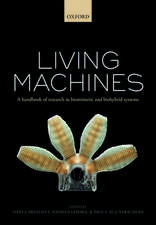Neurobiology of Interval Timing: Advances in Experimental Medicine and Biology, cartea 829
Editat de Hugo Merchant, Victor de Lafuenteen Limba Engleză Paperback – 27 sep 2016
| Toate formatele și edițiile | Preț | Express |
|---|---|---|
| Paperback (1) | 952.57 lei 6-8 săpt. | |
| Springer – 27 sep 2016 | 952.57 lei 6-8 săpt. | |
| Hardback (1) | 1554.72 lei 6-8 săpt. | |
| Springer International Publishing – 26 iun 2024 | 1554.72 lei 6-8 săpt. |
Din seria Advances in Experimental Medicine and Biology
- 9%
 Preț: 719.60 lei
Preț: 719.60 lei - 20%
 Preț: 691.93 lei
Preț: 691.93 lei - 5%
 Preț: 717.00 lei
Preț: 717.00 lei - 5%
 Preț: 716.28 lei
Preț: 716.28 lei - 5%
 Preț: 717.20 lei
Preț: 717.20 lei - 15%
 Preț: 640.24 lei
Preț: 640.24 lei - 5%
 Preț: 1113.83 lei
Preț: 1113.83 lei - 5%
 Preț: 715.71 lei
Preț: 715.71 lei - 5%
 Preț: 820.43 lei
Preț: 820.43 lei - 15%
 Preț: 641.38 lei
Preț: 641.38 lei - 5%
 Preț: 716.28 lei
Preț: 716.28 lei - 5%
 Preț: 523.99 lei
Preț: 523.99 lei - 5%
 Preț: 1031.00 lei
Preț: 1031.00 lei - 5%
 Preț: 717.00 lei
Preț: 717.00 lei - 5%
 Preț: 715.35 lei
Preț: 715.35 lei - 20%
 Preț: 1161.71 lei
Preț: 1161.71 lei - 5%
 Preț: 1170.51 lei
Preț: 1170.51 lei - 18%
 Preț: 1119.87 lei
Preț: 1119.87 lei - 5%
 Preț: 1288.48 lei
Preț: 1288.48 lei - 5%
 Preț: 1164.67 lei
Preț: 1164.67 lei - 5%
 Preț: 1101.73 lei
Preț: 1101.73 lei - 18%
 Preț: 1123.67 lei
Preț: 1123.67 lei - 5%
 Preț: 1435.64 lei
Preț: 1435.64 lei - 20%
 Preț: 1044.10 lei
Preț: 1044.10 lei - 18%
 Preț: 946.39 lei
Preț: 946.39 lei - 5%
 Preț: 292.57 lei
Preț: 292.57 lei - 18%
 Preț: 957.62 lei
Preț: 957.62 lei - 18%
 Preț: 1235.76 lei
Preț: 1235.76 lei - 5%
 Preț: 1231.55 lei
Preț: 1231.55 lei - 5%
 Preț: 1292.30 lei
Preț: 1292.30 lei - 5%
 Preț: 1102.10 lei
Preț: 1102.10 lei - 18%
 Preț: 1132.81 lei
Preț: 1132.81 lei - 5%
 Preț: 1165.19 lei
Preț: 1165.19 lei - 5%
 Preț: 1418.48 lei
Preț: 1418.48 lei - 5%
 Preț: 1305.63 lei
Preț: 1305.63 lei - 18%
 Preț: 1417.72 lei
Preț: 1417.72 lei - 18%
 Preț: 1412.99 lei
Preț: 1412.99 lei - 24%
 Preț: 806.16 lei
Preț: 806.16 lei - 18%
 Preț: 1243.29 lei
Preț: 1243.29 lei - 5%
 Preț: 1429.44 lei
Preț: 1429.44 lei - 5%
 Preț: 1618.70 lei
Preț: 1618.70 lei - 5%
 Preț: 1305.12 lei
Preț: 1305.12 lei - 18%
 Preț: 1124.92 lei
Preț: 1124.92 lei - 5%
 Preț: 1097.54 lei
Preț: 1097.54 lei - 15%
 Preț: 649.87 lei
Preț: 649.87 lei - 5%
 Preț: 1097.54 lei
Preț: 1097.54 lei - 18%
 Preț: 945.79 lei
Preț: 945.79 lei - 5%
 Preț: 1123.16 lei
Preț: 1123.16 lei
Preț: 952.57 lei
Preț vechi: 1161.67 lei
-18% Nou
Puncte Express: 1429
Preț estimativ în valută:
182.28€ • 194.91$ • 151.98£
182.28€ • 194.91$ • 151.98£
Carte tipărită la comandă
Livrare economică 18 aprilie-02 mai
Preluare comenzi: 021 569.72.76
Specificații
ISBN-13: 9781493944965
ISBN-10: 1493944967
Pagini: 358
Ilustrații: XIII, 358 p. 96 illus., 46 illus. in color.
Dimensiuni: 178 x 254 mm
Greutate: 0.65 kg
Ediția:2014
Editura: Springer
Colecția Springer
Seria Advances in Experimental Medicine and Biology
Locul publicării:New York, NY, United States
ISBN-10: 1493944967
Pagini: 358
Ilustrații: XIII, 358 p. 96 illus., 46 illus. in color.
Dimensiuni: 178 x 254 mm
Greutate: 0.65 kg
Ediția:2014
Editura: Springer
Colecția Springer
Seria Advances in Experimental Medicine and Biology
Locul publicării:New York, NY, United States
Cuprins
Introduction to the Neurobiology of Interval Timing.- About the (non)scalar property for time perception.- Elucidating the internal structure of psychophysical timing performance in the sub-second and second range by utilizing confirmatory factor analysis.- Neurocomputational models
of time perception.- Dedicated Clock/Timing-Circuit Theories of Time Perception and Timed Performance.- Neural Dynamics Based Timing in the Subsecond to Seconds Range.- Signs of timing in motor cortex during movement preparation and cue anticipation.- Neurophysiology of timing in the hundreds of milliseconds: multiple layers of neuronal clocks in the medial premotor areas.- The Olivo-Cerebellar System as a Neural Clock.- From duration and distance comparisons to goal encoding in prefrontal cortex.- Probing Interval Timing with Scalp-recorded Electroencephalography (EEG).- Searching for the Holy Grail: Temporally Informative Firing Patterns in the Rat.- Getting the timing right: experimental protocols for investigating time with functional neuroimaging and psychopharmacology.- Motor and Perceptual timing in Parkinson’s disease.- Music Perception: Information Flow within the Human Auditory Cortices.- Perceiving temporal regularity in music: The role of auditory event-related potentials (ERPs) in probing beat perception.- Neural Mechanisms of Rhythm Perception: Present Findings and Future Directions.- Neural underpinnings of music: The polyrhythmic brain.
of time perception.- Dedicated Clock/Timing-Circuit Theories of Time Perception and Timed Performance.- Neural Dynamics Based Timing in the Subsecond to Seconds Range.- Signs of timing in motor cortex during movement preparation and cue anticipation.- Neurophysiology of timing in the hundreds of milliseconds: multiple layers of neuronal clocks in the medial premotor areas.- The Olivo-Cerebellar System as a Neural Clock.- From duration and distance comparisons to goal encoding in prefrontal cortex.- Probing Interval Timing with Scalp-recorded Electroencephalography (EEG).- Searching for the Holy Grail: Temporally Informative Firing Patterns in the Rat.- Getting the timing right: experimental protocols for investigating time with functional neuroimaging and psychopharmacology.- Motor and Perceptual timing in Parkinson’s disease.- Music Perception: Information Flow within the Human Auditory Cortices.- Perceiving temporal regularity in music: The role of auditory event-related potentials (ERPs) in probing beat perception.- Neural Mechanisms of Rhythm Perception: Present Findings and Future Directions.- Neural underpinnings of music: The polyrhythmic brain.
Recenzii
“This is an outstanding textbook on the neurophysiology of coding with mathematical and statistical models. … I highly recommend this outstanding textbook to all interested audiences including neurophysiologists, neuroscientists, neurologists, and neurosurgeons in the research field involving timing mechanisms through psychophysics, probability theory, and mathematical modeling.” (Joseph J. Grenier, Amazon.com, May, 2015)
Caracteristici
Explores the current knowledge of neurobiology of timing behavior Includes up to date chapters written by leading experts in the fields of psychophysics, functional imaging, system neurophysiology, and musicology Discusses both animal behavior and human cognition with regard to the passage of time in a behavioral context Includes supplementary material: sn.pub/extras
Notă biografică
Hugo Merchant, PhD, is Professor of Neurobiology and Systems Neuroscience, Institute of Neurobiology, Universidad Nacional Autonoma de Mexico, Juriquilla, Mexico. His research focuses on the neural basis of time. He has served as Associate Editor of the Journal of Neuroscience of and the Journal of Neurophysiology, and on the Editorial Boards of eLife, Frontiers in System Neuroscience, and Frontiers in Integrative Neuroscience.
Victor de Lafuente, PhD, is Professor of Neurobiology, Institute of Neurobiology, Universidad Nacional Autonoma de Mexico, Queretaro, Mexico. His research interests are centered around the neuronal correlates of sensory perception, motor planning, and decision making. He is on the Board of Senior Editors for Neuroscience and is on the Editorial Boards of Frontiers In Molecular Neurobiology and Frontiers in Systems Neuroscience
Victor de Lafuente, PhD, is Professor of Neurobiology, Institute of Neurobiology, Universidad Nacional Autonoma de Mexico, Queretaro, Mexico. His research interests are centered around the neuronal correlates of sensory perception, motor planning, and decision making. He is on the Board of Senior Editors for Neuroscience and is on the Editorial Boards of Frontiers In Molecular Neurobiology and Frontiers in Systems Neuroscience
Textul de pe ultima copertă
The study of how the brain processes time is becoming one of the most important topics in systems, cellular, computational, and cognitive neuroscience, as well as in the physiologic bases of music and language. During the last and current decade, interval timing has been intensively studied in humans and animals using increasingly sophisticated approaches. This new edition of the Neurobiology of Interval Timing integrates the current knowledge of animal behavior and human cognition of the passage of time in different behavioral contexts, including the perception and production of time intervals, as well as rhythmic activities. The chapters are written by the leading experts in the fields of psychophysics, functional imaging, systems neurophysiology, and musicology. The new edition features a complete updating of the content with many new chapters. The main updates are the remarkable advances in our understanding of the neural basis of temporal processing in monkeys, rodents, and humans. The notion is that the neural clock depends on the dynamics of neural populations in the motor system, and that this general internal time representation interacts with the sensory and cognitive systems depending on the timing requirements and the behavioral contingencies of a specific task. Also, this edition delineates a clearer distinction between interval-based and beat-based timing in humans.






















